Introduction
Tropical sod webworm larvae are destructive pests of warm season turfgrasses in the southeastern US, especially on newly established sod, lawns, athletic fields, and golf courses. Larval feeding damage reduces turfgrass aesthetics, vigor, photosynthesis and density. The first sign of damage is often caused by differences in grass height in areas where larvae are feeding. Tropical sod webworms are part of a pest complex of warm season turf caterpillars in Florida that include fall armyworm (Spodoptera frugiperda), striped grass loopers (Mocis spp.), and the fiery skipper (Hylephila phyleus).
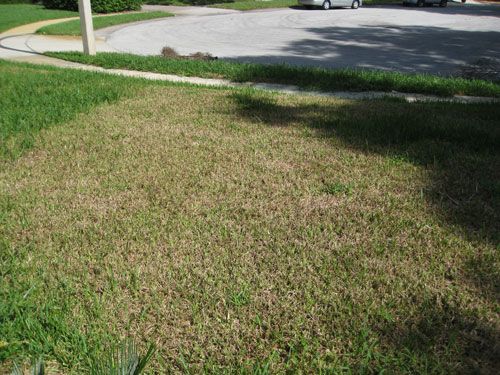
Credit: Steven Arthurs, University of Florida
Distribution
Herpetogramma species attack turfgrasses throughout the 'tropical zone', including Guam, Puerto Rico, Jamaica, Australia, Hawaii, and the United States. In North America, Herpetogramma phaeopteralis has been previously recorded from Florida, Georgia, Louisiana, Texas, Hawaii, Mississippi, Alabama, and the Caribbean islands (Kerr 1955; Meagher et al. 2007); however, a comprehensive survey for this pest has not been conducted in recent years.
Description
Adults
The moths are dingy brown, and their wing spread is about 20 mm (3/4 inch). At rest, wings are held in a triangular shape. Adult males usually have six abdominal segments, whereas females have five. The terminal segment in males has a slim extension, while the anal segment of the female has a large fusiform opening.

Credit: James Kerrigan, University of Florida

Credit: James Kerrigan, University of Florida
Eggs
Adult females deposit clusters of 10 to 35 creamy-white eggs on the upper surface of grass blades. The eggs become brownish-red as they mature. The eggs are flattened, overlapping, and slightly oval in shape. Eggs average 0.7 mm (length), 0.5 mm (width), and 0.1 mm (height).
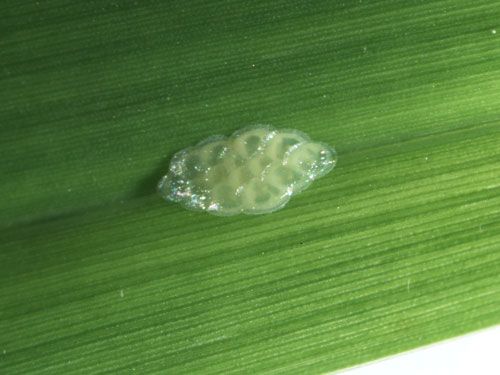
Credit: Nastaran Tofangsazi, University of Florida
Larvae
Caterpillars are cream-colored with brown spots on each segment and a dark, yellowish brown head. There are six instars, and larval head capsules at their widest points measure 0.225, 0.344, 0.489, 0.676, 0.944, and 1.267 mm, respectively. Average body length of each instar is 1.2, 2.7, 4.1, 6.0, 8.4, and 11.3 mm, respectively.

Credit: James Kerrigan, University of Florida
Pupae
The reddish brown pupae are about 8.5 to 9.5 mm long and 2.1 to 2.9 mm wide. The pupae are normally buried in the upper thatch.
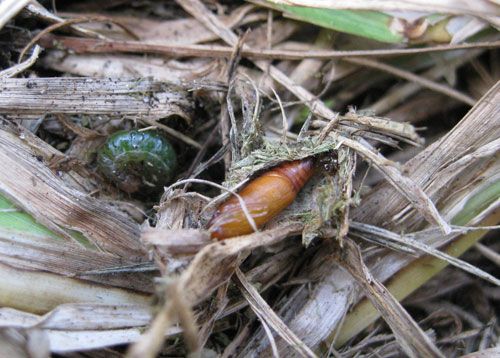
Credit: Steven Arthurs, University of Florida
Seasonal Biology
In southern Florida, tropical sod webworm adults are present year round, with significantly higher numbers in the fall (September–November). Populations decline over the winter and increase slightly beginning in the spring (March–May) (Cherry and Wilson 2005). In more northern regions of Florida (Gainesville), the peak of flight activity was reported in October and November (Kerr 1955) and August–October (John Capinera, unpublished observations). Indications are that this species does not survive the winter in the northern part of the state (Kerr 1955), and thus seems possible that some seasonal migration of this species may occur.
Adults rest in sheltered and shrubby areas during the day and are active at dusk (Cherry and Wilson 2005). Adult tropical sod webworms have been observed feeding on nectar sources (Sourakov 2008). Females deposit eggs on grass blades in the evening, and eggs hatch in 3 to 4 days. Tropical sod webworms develop through six larval instars, pre-pupal and pupal stages over 21 to 47 days, depending on temperature. Multiple generations may occur during a year (e.g. three or four generations in southern Florida). Tofangsazi et al. (2012) reported that the lower, upper, and optimum thermal thresholds were 15°C, 35°C, and 30°C, respectively.
Hosts
Tropical sod webworm is a pest of all warm season turf grasses, including centipedegrass (Eremochloa ophiuroides [Munro.] Hack.), bermudagrass (Cynodon spp.), seashore paspalum (Paspalum vaginitium Swartz), carpetgrass (Axonopus spp.), zoysiagrass (Zoysia japonica Steudel), bahiagrass (Paspalum notatum Flüggé) and St. Augustinegrass (Stenotaphrum secundatum [Walter] Kuntze). This species is also known to feed on cool season grasses including creeping bentgrass Agrostis stolonifera L.
Economic Importance
Turfgrass (sod) production is an important industry in the United States covering more than 25 million hectares, and Florida is one of the main sod producing states cultivating an estimated 37,635 ha and harvesting over 25,495 ha annually (Haydu et al. 2006). Tropical sod webworm is an economically injurious pest of turfgrasses including St. Augustinegrass, the most common turfgrass planted in home lawns in Florida (Trenholm and Unruh 2004). Several large outbreaks of this pest have been reported from Florida and Texas.
Damage
Larvae are the damaging stages. Neonates (first instar larvae) are small (1 mm long) and their feeding activity is hardly noticeable. The first four larval stages (instars) are 'window feeders', i.e., they only feed on the upper surface of grass blades, and so the injury they cause is often overlooked. Fifth and sixth instars can severely damage grass by chewing entire sections off the leaf blade. Larval feeding occurs at night, and larvae hide in the thatch during the day. Caterpillars prefer dry and hot grass areas. Early damage is hard to notice and creates a ragged appearance, but as larvae grow, they consume considerable quantities of grass before pupating. Grass may recover if infestations are not too severe, but feeding damage causes yellowish and brown patches and often leads to the ingress of weeds.
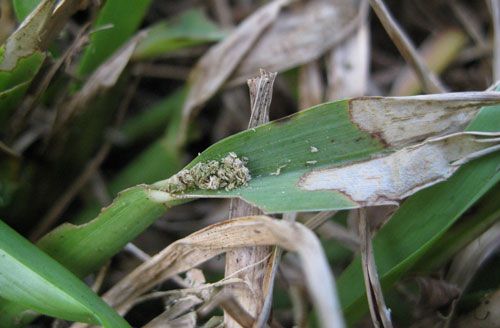
Credit: Steven Arthurs, University of Florida
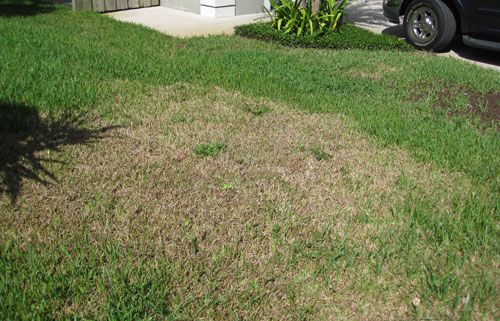
Credit: Steven Arthurs, University of Florida
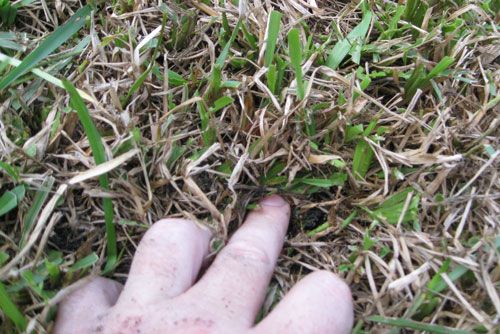
Credit: Steven Arthurs, University of Florida
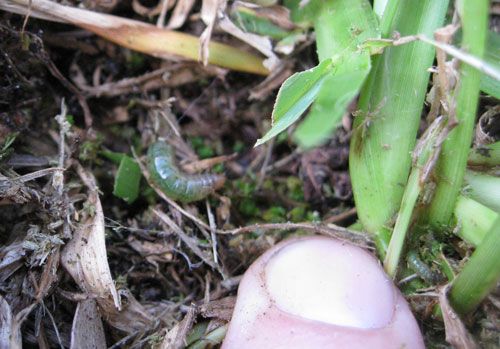
Credit: Steven Arthurs, University of Florida
Management
Despite the economic importance of Herpetogramma phaeopteralis, little information on integrated pest management programs of this pest has been reported. Several insecticides may be used to control this pest, but appropriate timing, risks of resistance, and non-target impacts need to be considered. Finding larvae with soap flushes, especially if moths were previously seen, and spot treatment of infested areas are recommended. The sex pheromone of this species, which would allow sex-based monitoring, has not been described.
Chemical Control
Current control recommendations for Herpetogramma phaeopteralis are mainly application of above-ground chemical insecticides against larval stages. Control should be against damaging larvae, not the flying moths. Small larvae are generally easier to control than larger larvae. At least 10 chemical compounds are currently registered for control of lawn caterpillars including sod webworms in North America (Tofangsazi et al. 2015).
Cultural Control
Healthy turfgrass, proper fertilization, irrigation and proper mowing can decrease susceptibility of turfgrass against tropical sod webworm. Excessive fertilizing is a leading cause of caterpillar outbreaks in lawns. Healthy turfgrass can also better maintain an acceptable appearance under low to moderate insect infestation pressure. Furthermore, cultural practices such as tillage, thatch removal by vertical mowing or power raking can reduce pest populations. Because eggs are laid on grass blades, removal of grass clipping during this time might also reduce populations.
Host Plant Resistance
Plant resistance is a potential tool for managing tropical sod webworm. The following cultivars of St. Augustinegrass were susceptible to Herpetogramma phaeopteralis: 'DelMar', 'Floralawn', 'Floratam', 'Mercedes', 'Nortam', 'Palmetto', 'Raleigh', 'Seville', and 'Texas Common'. However, moderate levels of resistance have been observed in cultivars including 'Amerishade', 'Floratine', 'FX-10', 'Captiva', and 'Winchester'. Certain zoysiagrass genotypes and cultivars including 'Cavalier', DALZ8501, and JZ-l exhibited high resistance to tropical sod webworm (Reinert and Engelke 2001; Reinert et al. 2009).
Biological Insecticides
Entomopathogenic nematodes (esp. Steinernema carpocapsae) have been successfully tested against tropical sod webworms in Florida (Tofangsazi et al. 2014). Entomopathogenic fungi (esp. Beauveria bassiana), and the bacterial-based insecticides Bacillus thuringiensis var. kurstaki and aizawai, and spinosad (Saccharopolyspora spinosa by-product) may help control sod webworms without impacting beneficial species.
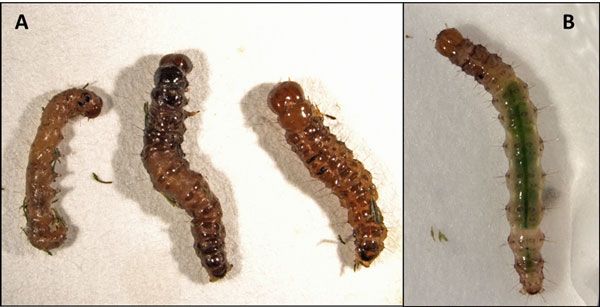
Credit: Nastaran Tofangsazi, University of Florida
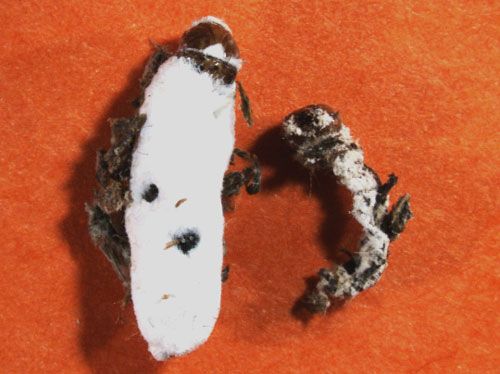
Credit: Nastaran Tofangsazi, University of Florida
Natural Controls
Beneficial arthropods observed attacking tropical sod webworm include several generalist predators, i.e., spiders, lady beetles, big-eyed bugs, syrphid flies, ground beetles, rove beetles, and a variety of parasitoids, mostly Trichogramma and an ichneumonid wasp (Horogenes sp.). Trichogramma fuentesi, was observed parasitizing >80% of sod webworm eggs in our colony. Preserving natural enemies by using low-toxicity insecticides may help limit outbreaks of this pest. However, the impact of biological control agents on tropical sod webworm has not been documented.
Selected References
Cherry R, Wilson A. 2005. "Flight activity of tropical sod webworms (Lepidoptera: Pyralidae)." Florida Entomologist 88: 101–103.
Haydu JJ, Hodges AW, Hall CR. 2006. Economic Impacts of the Turfgrass and Lawncare Industry in the United States. FE632. Gainesville: University of Florida Institute of Food and Agricultural Sciences. https://edis.ifas.ufl.edu/fe632
Kerr SH. 1955. "Life history of the tropical sod webworm Pachyzancla phaeopteralis Guenée." Florida Entomologist 38: 3–11.
Meagher RL, Epsky ND, Cherry R. 2007. "Mating behavior and female-produced pheromone use in tropical sod webworm (Lepidoptera: Crambidae)." Florida Entomologist 90: 304–308.
Reinert JA, Engelke MC. 2001. "Resistance in zoysiagrass, Zoysia spp., to the tropical sod webworm, Herpetogramma phaeopteralis." International Turfgrass Society Research Journal 9: 798–801.
Reinert JA, Engelke MC, Genovesi AD, Chandra A, McCoy JE. 2009. "Resistance to tropical sod webworm (Herpetogramma phaeopteralis) (Lepidoptera: Crambidae) in St. Augustinegrass and zoysiagrass." International Turfgrass Society Research Journal 11: 663–673.
Sourakov A. 2008. "Trophic interactions involving Herpetogramma phaeopteralis (Lepidoptera: Pyralidae) and Passiflora incarnata (Passifloraceae)." Florida Entomologist 91: 136–138.
Tofangsazi N, Buss EA, Meagher RL, Mascarin GM, Arthurs SP. 2012. "Thermal requirements and development of Herpetogramma phaeopteralis (Lepidoptera: Crambidae: Spilomelinae)." Journal of Economic Entomology 105: 1573–1580..
Tofangsazi N, Cherry RH, Arthurs SP. 2014. "Efficacy of commercial formulations of entomopathogenic nematodes against tropical sod webworm, Herpetogramma phaeopteralis (Lepidoptera: Crambidae)." Journal of Applied Entomology 138: 656–661.
Tofangsazi N, Cherry R H, Beeson RC, Arthurs SP. 2015. "Concentration–response and residual activity of insecticides to control Herpetogramma phaeopteralis (Lepidoptera: Crambidae) in St. Augustinegrass." Journal of Economic Entomology 108: 730–735.
Trenholm LE, Unruh JB. 2004. Florida Lawn Handbook. Gainesville, FL: University of Florida Press.